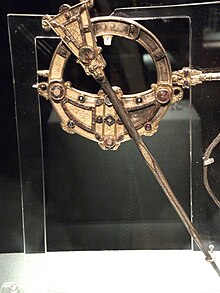Kilmainham Brooch
[3][4] The brooch is dated to the late 8th or early 9th century based on its 8th-century design patterns, along with the fact that silver was not easily available in Ireland until the first Viking invasion in AD 795.
Its top contains a wide oval compartment or cell bearing traces of red enamel, while the sides are formed from gold plates bounded by twisted wires and interlace decorations.
[10] Although described in 1989 as "probably Irish",[11] it contains structural and decorative designs, including its lobed (ie "hanging") terminals, small cusps, and the cartouche on the hoop, are reminiscent of the Pictish-syle, indicating that it may be of Northumbrian origin (unlikely), or at least heavily influenced by that style.
Examples such as the Kilmainham Brooch were built by skilled craftsmen and their workshops using precious metal, and intended as status symbols for wealthy (and often female) commissioners.
[14] It was found in the mid-18th century at a late 9th- and early 10th-century Viking burial site at Kilmainham, County Dublin, Ireland,[4] alongside swords and other artifacts of Scandinavian origin or influence.
[15] After further excavations in the 21st century, the area of Kilmainham-Islandbridge was described by historian Stephen Harrison as "demonstrably the largest burial complex of its type in western Europe, Scandinavia excluded".
[21][22] Both were produced during the Celtic Revival when there was high demand for replicas of objects from Ireland's medieval period, particularly from its "Golden Age of Irish Art", roughly AD 700–1200 (especially for metalwork).


